Multiscale Characterization at Early Ages of Ultra-High Performance Geopolymer Concrete
Abstract
1. Introduction
2. Materials and Experimental Methods
2.1. Materials
2.2. Samples Preparation
2.3. Experimental Methods
2.3.1. Fresh, Mechanical, and Durability Tests
2.3.2. Microstructure Analysis
3. Results and Discussion
3.1. Flowability
3.2. Setting Time
3.3. Early Compressive Strength
3.4. Ultrasonic Pulse Velocity Test
3.5. Relation between the Compressive Strength and Dry Unit Weight at Early Age
3.6. Water Sorptivity
3.7. Relation between the Freeze–Thaw Cycles and Compressive Strength
3.8. Microstructure of UHPGC
3.8.1. Scanning Electron Microscopy (SEM) and EDX Analysis
3.8.2. Thermal Analysis
3.8.3. FTIR Analysis
4. Conclusions and Future Recommendations
- It was found that every parameter considered in this study affected UHPGC’s early compressive strength. So, increasing KOH molarity decreases the setting times of mixtures, while decreasing KOH molarity increases the flowability of UHPGC mixtures.
- Adding silica fume up to 30% of the total aluminosilicate materials increased the early compressive strength of concrete up to 134 MPa in one day. Compressive strength decreased with the decrease in KOH molarity and curing temperature.
- Early strength compressive for all employed binders is enhanced by increasing the curing temperature from ambient curing to 100 °C. Early compressive strength for all binders is improved by increasing KOH molarity from 12 M to 16 M.
- UHPGC mixtures cured without heat gained strength gradually over time, but those cured at 60 and 100 °C for 8 and 24 h gained significant strength with time.
- The results indicate that the addition of fly ash to the UHPGC mixtures causes the early compressive strength to be decreased.
- In comparison to the control mix (100% GGBS) and the UHPGC mixture containing FA (90% GGBS + 10% FA), SEM micrographs demonstrate that the UHPGC combination with the optimal SF concentration (70% GGBS + 30% SF) obtains the densest microstructure. The optimum UHPGC mixture (G5) retained more than 95% of its weight, while the control mixtures (G1) lost 6% of their weight, according to TGA/DTA analysis.
- UHPGC enhanced with silica fume is a viable binder for high-strength concrete production under heat-curing conditions. Mixtures containing 70% slag, 30% silica fume, and 16 KOH molarity with heat curing are the best for early compressive strength and setting time comparable to the control mixture.
- As a recommendation, further research is needed on the durability of the early mechanical properties of UHPGC. The early strength of the one-part UHPGC needs more study. This will show a correlation between UHPGC’s early strength gain and aluminosilicate’s alkaline activation. The UHPGC study should also involve field application structural integrity.
Author Contributions
Funding
Institutional Review Board Statement
Informed Consent Statement
Data Availability Statement
Acknowledgments
Conflicts of Interest
References
- Zheng, J.; Tang, J.; Zhou, Z.; Heng, J.; Chu, X.; Wu, T. Intelligent cognition of traffic loads on road bridges: From measurement to simulation—A review. Measurement 2022, 200, 111636. [Google Scholar] [CrossRef]
- Prakash, R.; Raman, S.N.; Subramanian, C.; Divyah, N. Eco-friendly fiber-reinforced concretes. In Handbook of Sustainable Concrete and Industrial Waste Management; Woodhead Publishing: Sawston, UK, 2022; pp. 109–145. [Google Scholar]
- Divyah, N.; Thenmozhi, R.; Neelamegam, M.; Prakash, R. Characterization, and behavior of basalt fiber-reinforced lightweight concrete. Struct. Concr. 2021, 22, 422–430. [Google Scholar] [CrossRef]
- Majhi, S.; Mukherjee, A.; Spadaccini, A.F. Thermal performance of an alkali-activated paste for bonding fibre sheets with concrete. Compos. Part B Eng. 2019, 162, 43–53. [Google Scholar] [CrossRef]
- Gomaa, E.; Gheni, A.A.; Kashosi, C.; ElGawady, M.A. Bond strength of eco-friendly class C fly ash-based thermally cured alkali-activated concrete to portland cement concrete. J. Clean. Prod. 2019, 235, 404–416. [Google Scholar] [CrossRef]
- Prakash, R.; Thenmozhi, R.; Raman, S.N.; Subramanian, C. Characterization of eco-friendly steel fiber-reinforced concrete containing waste coconut shell as coarse aggregates and fly ash as partial cement replacement. Struct. Concr. 2020, 21, 437–447. [Google Scholar] [CrossRef]
- Tahwia, A.M.; El-Far, O.; Amin, M. Characteristics of sustainable high strength concrete incorporating eco-friendly materials. Innov. Infrastruct. Solut. 2022, 7, 1–3. [Google Scholar] [CrossRef]
- Li, H.; Deng, Q.; Zhang, J.; Xia, B.; Skitmore, M. Assessing the life cycle CO2 emissions of reinforced concrete structures: Four cases from China. J. Clean. Prod. 2019, 210, 496–1506. [Google Scholar] [CrossRef]
- Abdellatief, M.; Elemam, W.E.; Alanazi, H.; Tahwia, A.M. Production, and optimization of sustainable cement brick incorporating clay brick wastes using response surface method. Ceram. Int. 2022, 49, 144. [Google Scholar] [CrossRef]
- Prakash, R.; Thenmozhi, R.; Raman, S.N.; Subramanian, C.; Divyah, N. Mechanical characterization of sustainable fibre-reinforced lightweight concrete incorporating waste coconut shell as coarse aggregate and sisal fibre. J. Environ. Sci. Technol. 2021, 18, 1579–1590. [Google Scholar]
- Prakash, R.; Thenmozhi, R.; Raman, S.N. Mechanical characterization and flexural performance of eco-friendly concrete produced with fly ash as cement replacement and coconut shell coarse aggregate. Int. J. Environ. Sustain. Dev. 2019, 18, 131–148. [Google Scholar] [CrossRef]
- Ganesh, A.C.; Muthukannan, M. Development of high performance sustainable optimized fiber reinforced geopolymer concrete and prediction of compressive strength. J. Clean. Prod. 2021, 282, 124543. [Google Scholar] [CrossRef]
- Ling, Y.; Wang, K.; Li, W.; Shi, G.; Lu, P. Effect of slag on the mechanical properties and bond strength of fly ash-based engineered geopolymer composites. Compos. Part B Eng. 2019, 164, 747–757. [Google Scholar] [CrossRef]
- Huang, L.; Liu, J.-C.; Cai, R.; Ye, H. Mechanical degradation of ultra-high strength alkali-activated concrete subjected to repeated loading and elevated temperatures. Cem. Concr. Compos. 2021, 121, 104083. [Google Scholar] [CrossRef]
- Kuri, J.C.; Majhi, S.; Sarker, P.K.; Mukherjee, A. Microstructural and non-destructive investigation of the effect of high temperature exposure on ground ferronickel slag blended fly ash geopolymer mortars. J. Build. Eng. 2021, 43, 103099. [Google Scholar] [CrossRef]
- Cai, R.; Ye, H. Clinkerless ultra-high strength concrete based on alkali-activated slag at high temperatures. Cem. Concr. Res. 2021, 145, 106465. [Google Scholar] [CrossRef]
- Dong, M.; Feng, W.; Elchalakani, M.; Li, G.; Karrech, A.; May, E.F. Development of a High Strength Geopolymer by Novel Solar Curing. Ceram. Int. 2017, 43, 11233–11243. [Google Scholar] [CrossRef]
- Kuri, J.C.; Khan, M.N.; Sarker, P.K. Fresh and hardened properties of geopolymer binder using ground high magnesium ferronickel slag with fly ash. Constr. Build. Mater. 2021, 272, 121877. [Google Scholar] [CrossRef]
- Ambily, P.S.; Ravisankar, K.; Umarani, C.; Dattatreya, J.K.; Iyer, N.R. Development of ultra-high-performance geopolymer concrete. Mag. Concr. Res. 2014, 66, 82–89. [Google Scholar] [CrossRef]
- Yurt, Ü. High performance cementless composites from alkali activated GGBFS. Constr. Build. Mater. 2020, 264, 120222. [Google Scholar] [CrossRef]
- Zhang, N.; Hedayat, A.; Perera-Mercado, Y.; Bolaños Sosa, H.G.; Tupa, N.; Yanqui Morales, I.; Canahua Loza, R.S. Including Class F Fly Ash to Improve the Geopolymerization Effects and the Compressive Strength of Mine Tailings–Based Geopolymer. J. Mat. Civ. Eng. 2022, 34, 04022313. [Google Scholar] [CrossRef]
- Provis, P.J.L.; Van Deventer, J.S. (Eds.) Geopolymers: Structures; Properties and Industrial Applications; Elsevier: Amsterdam, The Netherlands, 2009. [Google Scholar]
- Aziz, I.H.; Abdullah, M.M.A.B.; Heah, C.-Y.; Liew, Y.-M. Behaviour changes of ground granulated blast furnace slag geopolymers at high temperature. Adv. Cem. Res. 2020, 32, 465–475. [Google Scholar] [CrossRef]
- Rovnaník, P. Effect of curing temperature on the development of hard structure of metakaolin-based geopolymer. Constr. Build. Mater. 2010, 24, 1176–1183. [Google Scholar] [CrossRef]
- Hassan, A.; Arif, M.; Shariq, M. Effect of curing condition on the mechanical properties of fly ash-based geopolymer concrete. SN Appl. Sci. 2019, 1, 1694. [Google Scholar] [CrossRef]
- Liu, Y.; Shi, C.; Zhang, Z.; Li, N.; Shi, D. Mechanical and fracture properties of ultra-high performance geopolymer concrete: Effects of steel fiber and silica fume. Cem. Concr. Compos. 2020, 112, 103665. [Google Scholar] [CrossRef]
- Mousavinejad, S.H.G.; Sammak, M. Strength and chloride ion penetration resistance of ultra-high-performance fiber reinforced geopolymer concrete. Structures 2021, 32, 1420–1427. [Google Scholar] [CrossRef]
- Tahwia, A.M.; Elgendy, G.M.; Amin, M. Mechanical properties of affordable and sustainable ultra-high-performance concrete. Case Stud. Constr. Mater. 2022, 16, e01069. [Google Scholar] [CrossRef]
- Aydın, S.; Baradan, B. The effect of fiber properties on high performance alkali-activated slag/silica fume mortars. Compos. Part B Eng. 2013, 45, 63–69. [Google Scholar] [CrossRef]
- Wetzel, A.; Middendorf, B. Influence of silica fume on properties of fresh and hardened ultra-high-performance concrete based on alkali-activated slag. Cem. Concr. Compos. 2017, 100, 53–59. [Google Scholar] [CrossRef]
- Lao, J.-C.; Xu, L.-Y.; Huang, B.-T.; Dai, J.-G.; Shah, S.P. Strain-hardening Ultra-High-Performance Geopolymer Concrete: Matrix design and effect of steel fibers. Compos. Commun. 2022, 30, 101081. [Google Scholar] [CrossRef]
- Kathirvel, P.; Sreekumaran, S. Sustainable development of ultra-high-performance concrete using geopolymer technology. J. Build. Eng. 2021, 39, 102267. [Google Scholar] [CrossRef]
- Wan, X.; Shen, C.; Wang, P.; Zhao, T.; Lu, Y. A study on fracture toughness of ultra-high toughness geopolymer composites based on Double-K Criterion. Constr. Build. Mater. 2020, 251, 118851. [Google Scholar] [CrossRef]
- Tahwia, A.M.; Ellatief, M.A.; Heneigel, A.M.; Elrahman, M.A. Characteristics of eco-friendly ultra-high performance geopolymer concrete incorporating waste materials. Ceram. Int. 2022, 48, 19662–19674. [Google Scholar] [CrossRef]
- Wong, H.H.C.; Kwan, A.K.H. Packing density of cementitious materials: Part 1—Measurement using a wet packing method. Mater. Struct. 2008, 41, 689–701. [Google Scholar] [CrossRef]
- Alanazi, H.; Hu, J.; Kim, Y.-R. Effect of slag, silica fume, and metakaolin on properties and performance of alkali-activated fly ash cured at ambient temperature. Constr. Build. Mater. 2019, 197, 747–756. [Google Scholar] [CrossRef]
- Alanazi, H.; Yang, M.; Zhang, D.; Gao, Z. Early strength and durability of metakaolin-based geopolymer concrete. Mag. Concr. Res. 2017, 69, 46–54. [Google Scholar] [CrossRef]
- Tahwia, A.M.; Heniegal, A.M.; Abdellatief, M.; Tayeh, B.A.; Elrahman, M.A. Properties of ultra-high performance geopolymer concrete incorporating recycled waste glass. Case Stud. Constr. Mater. 2022, 4, e01393. [Google Scholar] [CrossRef]
- Jiao, Y.; Zhang, Y.; Guo, M.; Zhang, L.; Ning, H.; Liu, S. Mechanical and fracture properties of ultra-high-performance concrete (UHPC) containing waste glass sand as partial replacement material. J. Clean. Prod. 2020, 277, 123501. [Google Scholar] [CrossRef]
- Juengsuwattananon, K.; Winnefeld, F.; Chindaprasirt, P.; Pimraksa, K. Correlation between initial SiO2/Al2O3, Na2O/Al2O3, Na2O/SiO2 and H2O/Na2O ratios on phase and microstructure of reaction products of metakaolin-rice husk ash geopolymer. Constr. Build. Mater. 2019, 226, 406–417. [Google Scholar] [CrossRef]
- Elyamany, H.E.; Elmoaty, A.E.M.A.; Elshaboury, A.M. Setting time and 7-day strength of geopolymer mortar with various binders. Constr. Build. Mater. 2018, 187, 974–983. [Google Scholar] [CrossRef]
- Assi, L.; Ghahari, S.; Deaver, E.; Leaphart, D.; Ziehl, P. Improvement of the early and final compressive strength of fly ash-based geopolymer concrete at ambient conditions. Constr. Build. Mater. 2016, 123, 806–813. [Google Scholar] [CrossRef]
- Katwal, U.; Aziz, T.; Tao, Z.; Uy, B.; Rahme, D. Tests of circular geopolymer concrete-filled steel columns under ambient and fire conditions. J. Constr. Steel Res. 2022, 196, 107393. [Google Scholar] [CrossRef]
- Yusuf, M.O.; Johari, M.A.; Ahmad, Z.A.; Maslehuddin, M. Effects of H2O/Na2O molar ratio on the strength of alkaline activated ground blast furnace slag-ultrafine palm oil fuel ash based concrete. Mater. Des. 2014, 56, 158–164. [Google Scholar] [CrossRef]
- Juengsuwattananon, K.; Pimraksa, K. Variable factors controlling amorphouszeolite phase transformation in metakaolin based geopolymer. Acta Metall. Slovac. 2017, 23, 378–386. [Google Scholar] [CrossRef]
- Xu, S.; Yuan, P.; Liu, J.; Pan, Z.; Liu, Z.; Su, Y.; Li, J.; Wu, C. Development and preliminary mix design of ultra-high-performance concrete based on geopolymer. Constr. Build. Mater. 2021, 308, 125110. [Google Scholar] [CrossRef]
- Qaidi, S.M.; Atrushi, D.S.; Mohammed, A.S.; Ahmed, H.U.; Faraj, R.H.; Emad, W.; Tayeh, B.A.; Najm, H.M. Ultra-high-performance geopolymer concrete: A review. Constr. Build. Mater. 2022, 346, 128495. [Google Scholar] [CrossRef]
- Nath, P.; Sarker, P.K.; Rangan, V.B. Early age properties of low-calcium fly ash geopolymer concrete suitable for ambient curing. Procedia Eng. 2015, 125, 601–607. [Google Scholar] [CrossRef]
- Assi, L.N.; Deaver, E.E.; ElBatanouny, M.K.; Ziehl, P. Investigation of early compressive strength of fly ash-based geopolymer concrete. Constr. Build. Mater. 2016, 112, 807–815. [Google Scholar] [CrossRef]
- Duan, P.; Yan, C.; Luo, W. A novel waterproof, fast setting and high early strength repair material derived from metakaolin geopolymer. Constr. Build. Mater. 2016, 124, 69–73. [Google Scholar] [CrossRef]
- Shen, J.; Li, Y.; Lin, H.; Lv, J.; Feng, S.; Ci, J. Early properties and chemical structure analysis of alkali-activated brick geopolymer with varied alkali dosage. J. Build. Eng. 2022, 60, 105186. [Google Scholar] [CrossRef]
- Li, M.; Huang, G.; Cui, Y.; Wang, B.; Chang, B.; Yin, Q.; Zhang, S.; Wang, Q.; Feng, J.; Ge, M. Coagulation Mechanism and Compressive Strength Characteristics Analysis of High-Strength Alkali-Activated Slag Grouting Material. Polymers 2022, 14, 3980. [Google Scholar] [CrossRef]
- Bao, J.; Zheng, R.; Yu, Z.; Zhang, P.; Song, Q.; Xu, J.; Gao, S. Freeze-thaw resistance of recycled aggregate concrete incorporating ferronickel slag as fine aggregate. Constr. Build. Mater. 2022, 356, 129178. [Google Scholar] [CrossRef]
- Tahwia, A.M.; Elgendy, G.M.; Amin, M. Durability and microstructure of eco-efficient ultra-high-performance concrete. Constr. Build. Mater. 2021, 303, 124491. [Google Scholar] [CrossRef]
- Radwan, M.K.H.; Mo, K.H.; Onn, C.C.; Ng, C.G.; Ling, T.-C. Waste press mud in enhancing the performance of glass powder blended cement. Constr. Build. Mater. 2021, 313, 125469. [Google Scholar] [CrossRef]
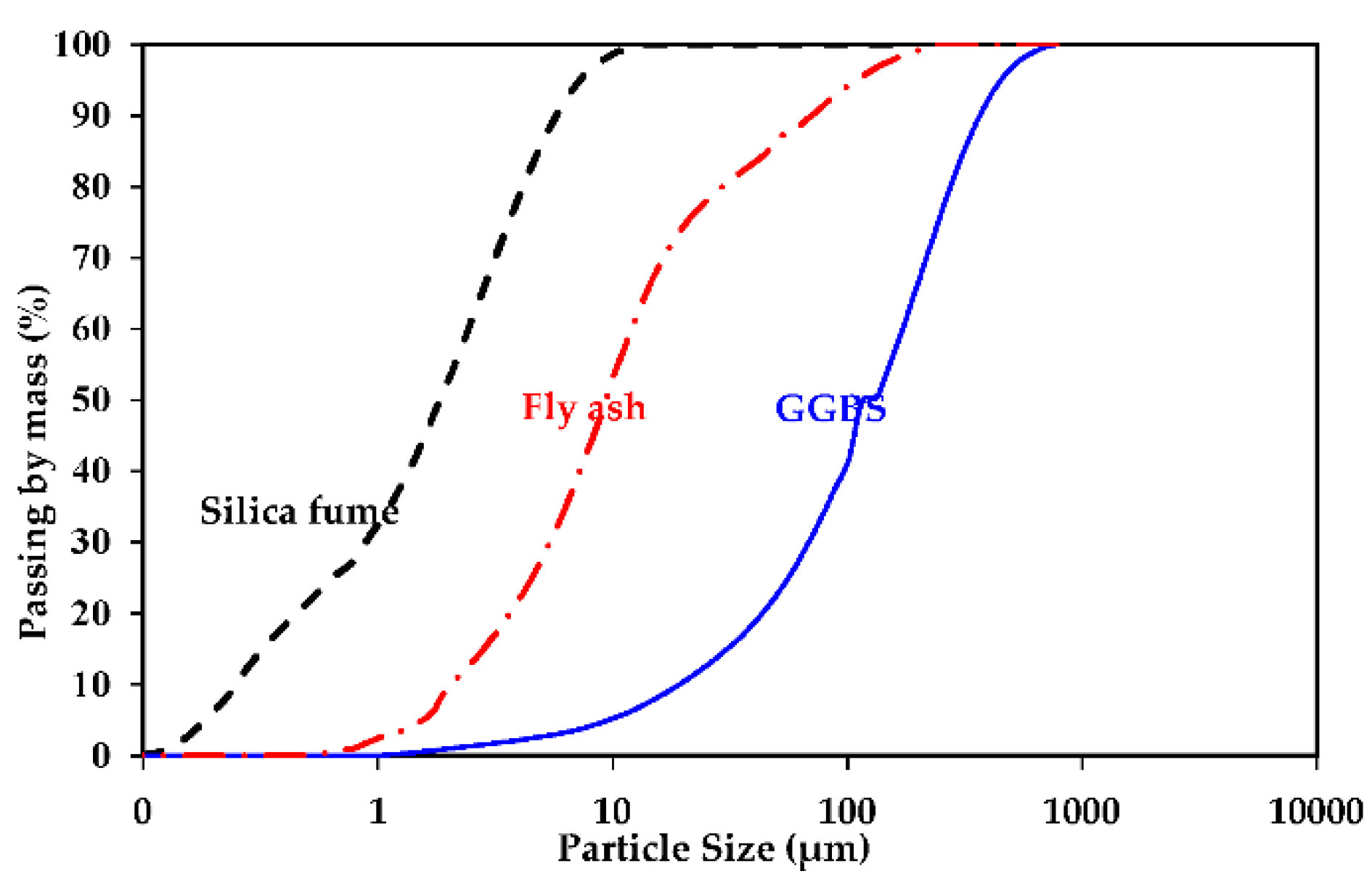
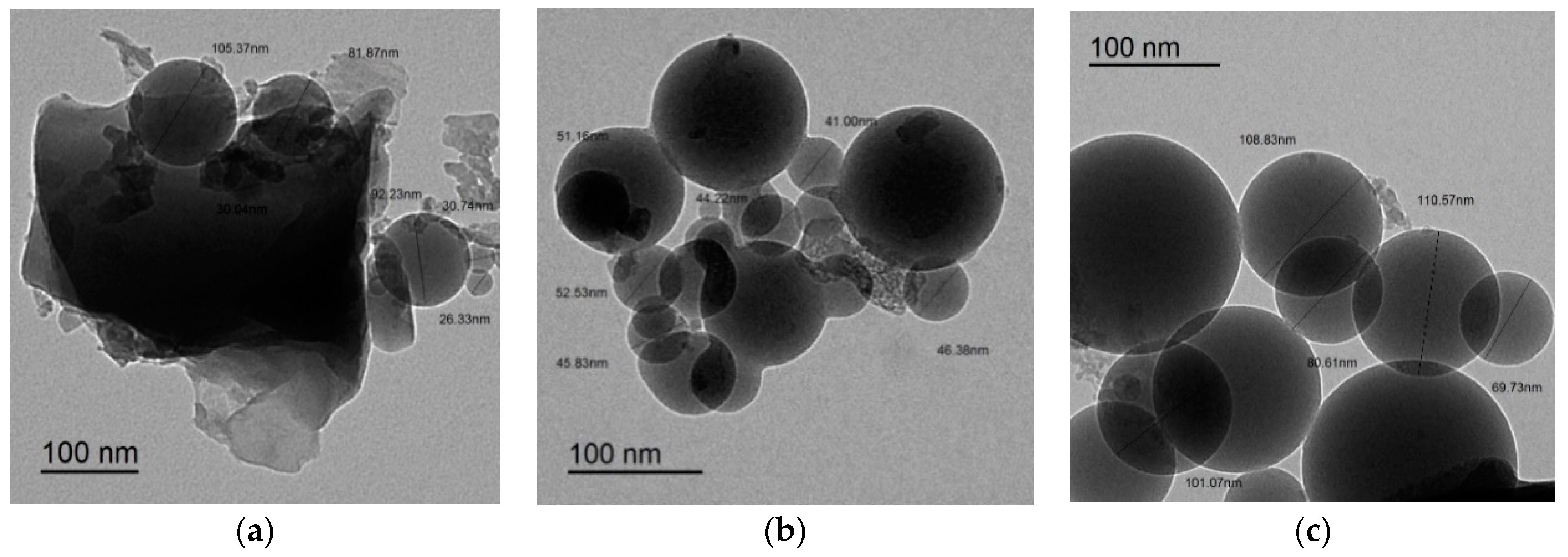
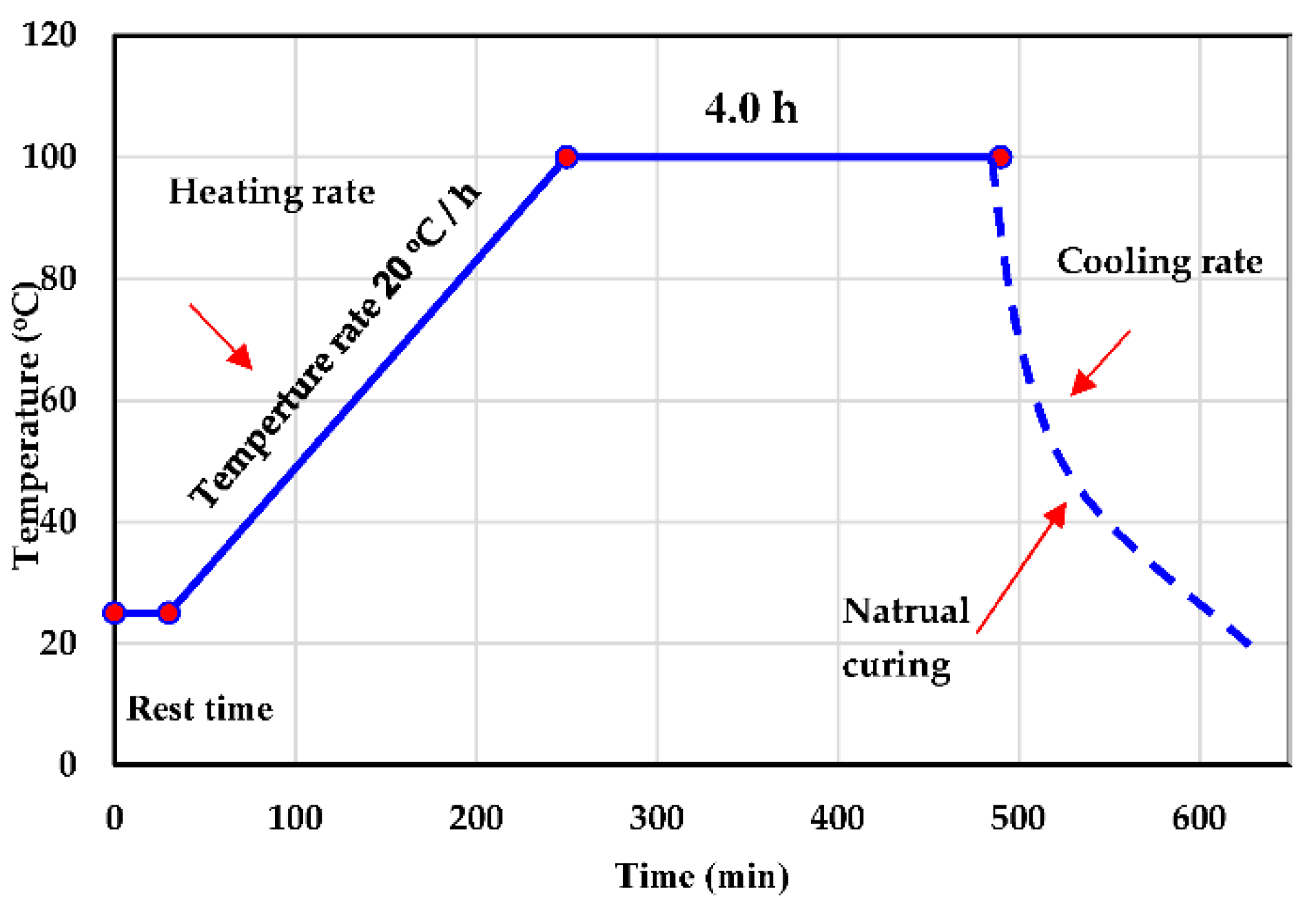

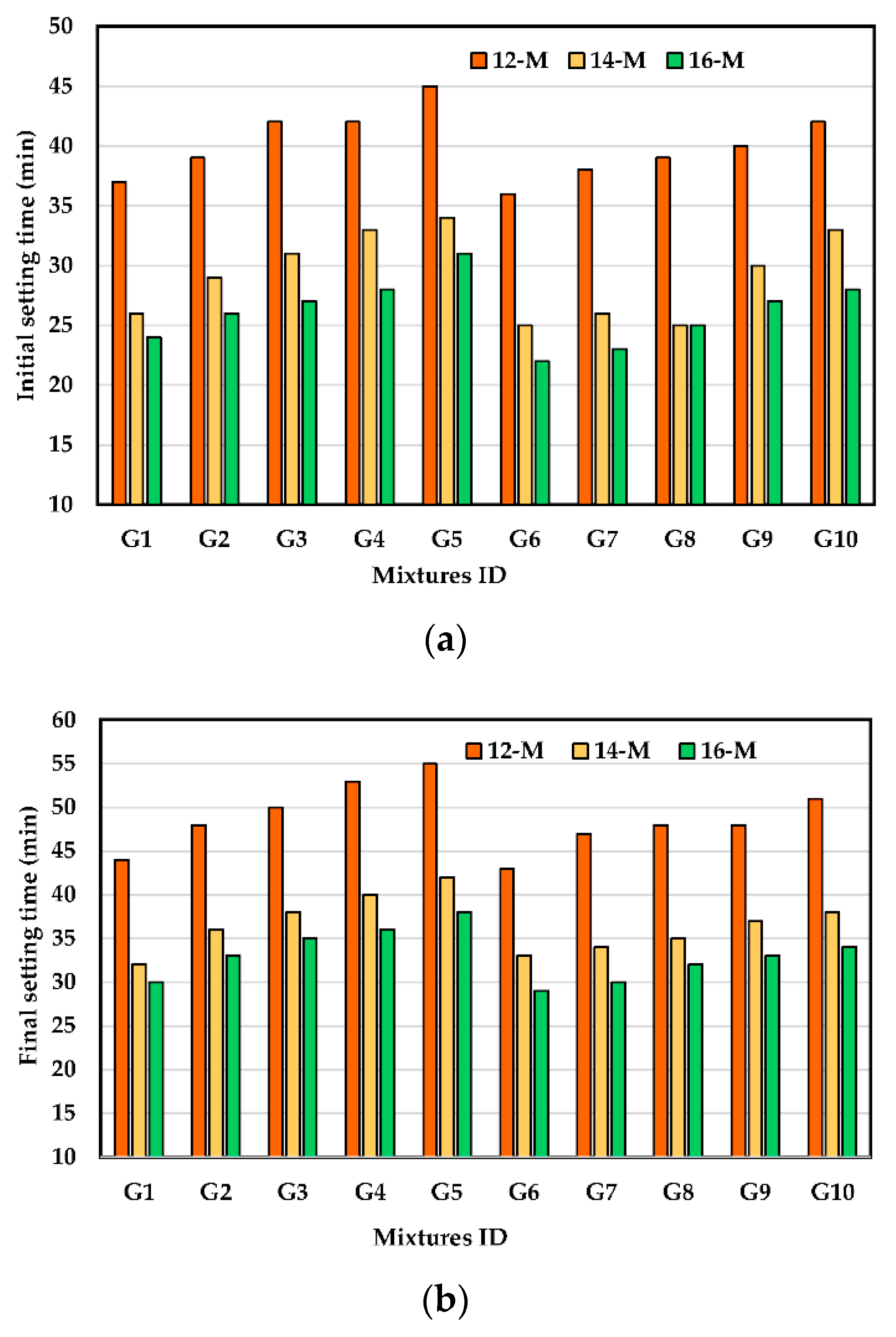
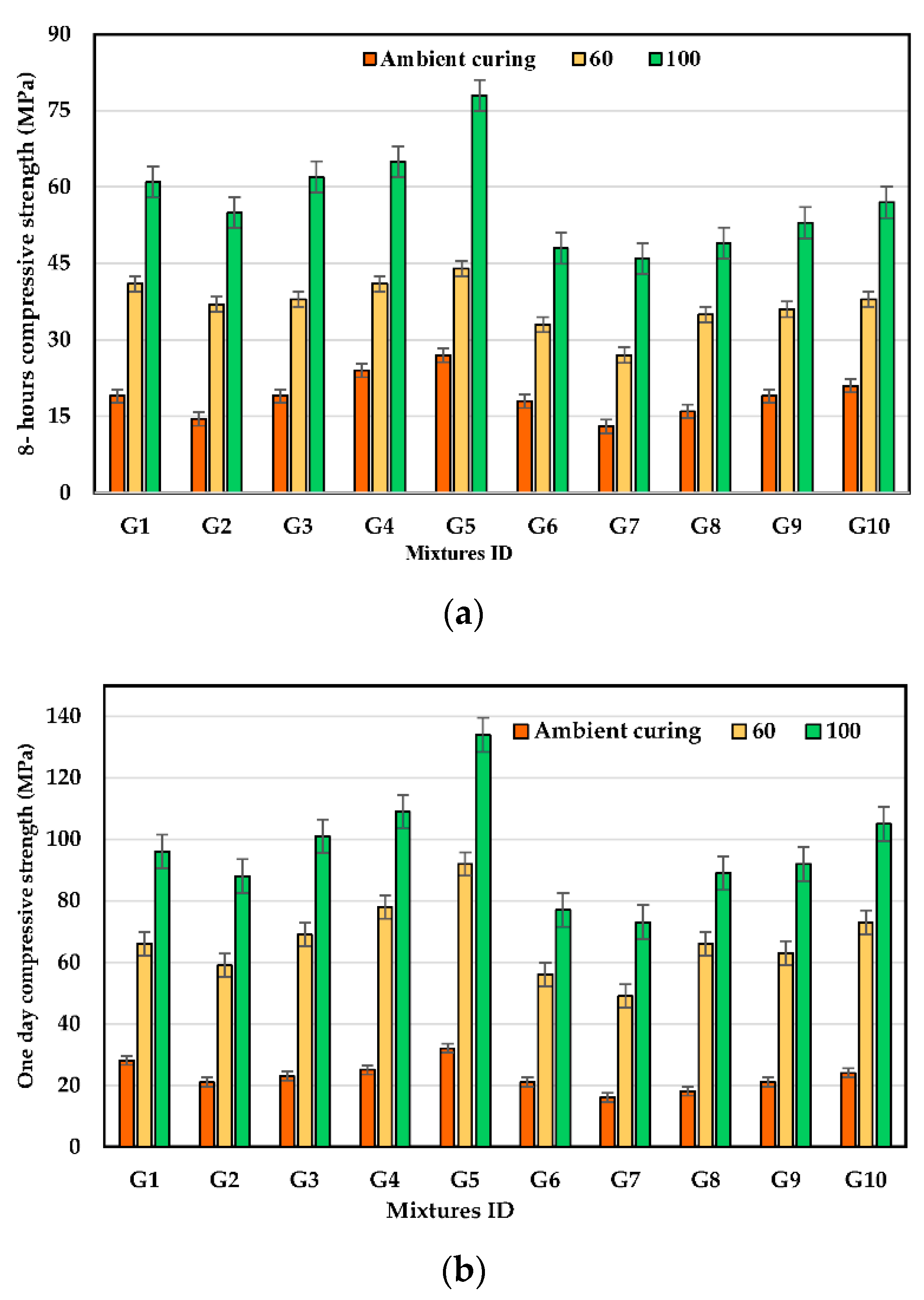
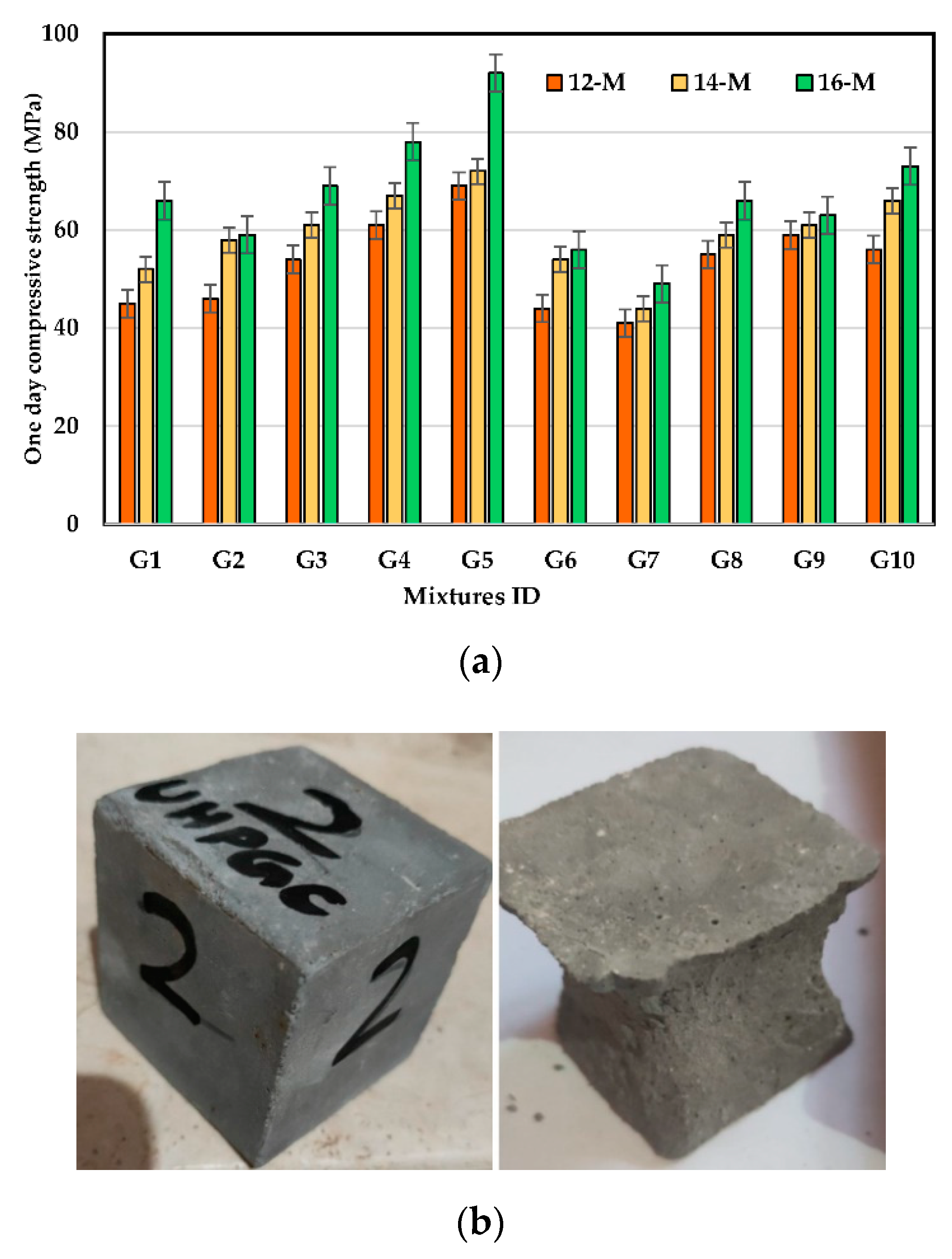
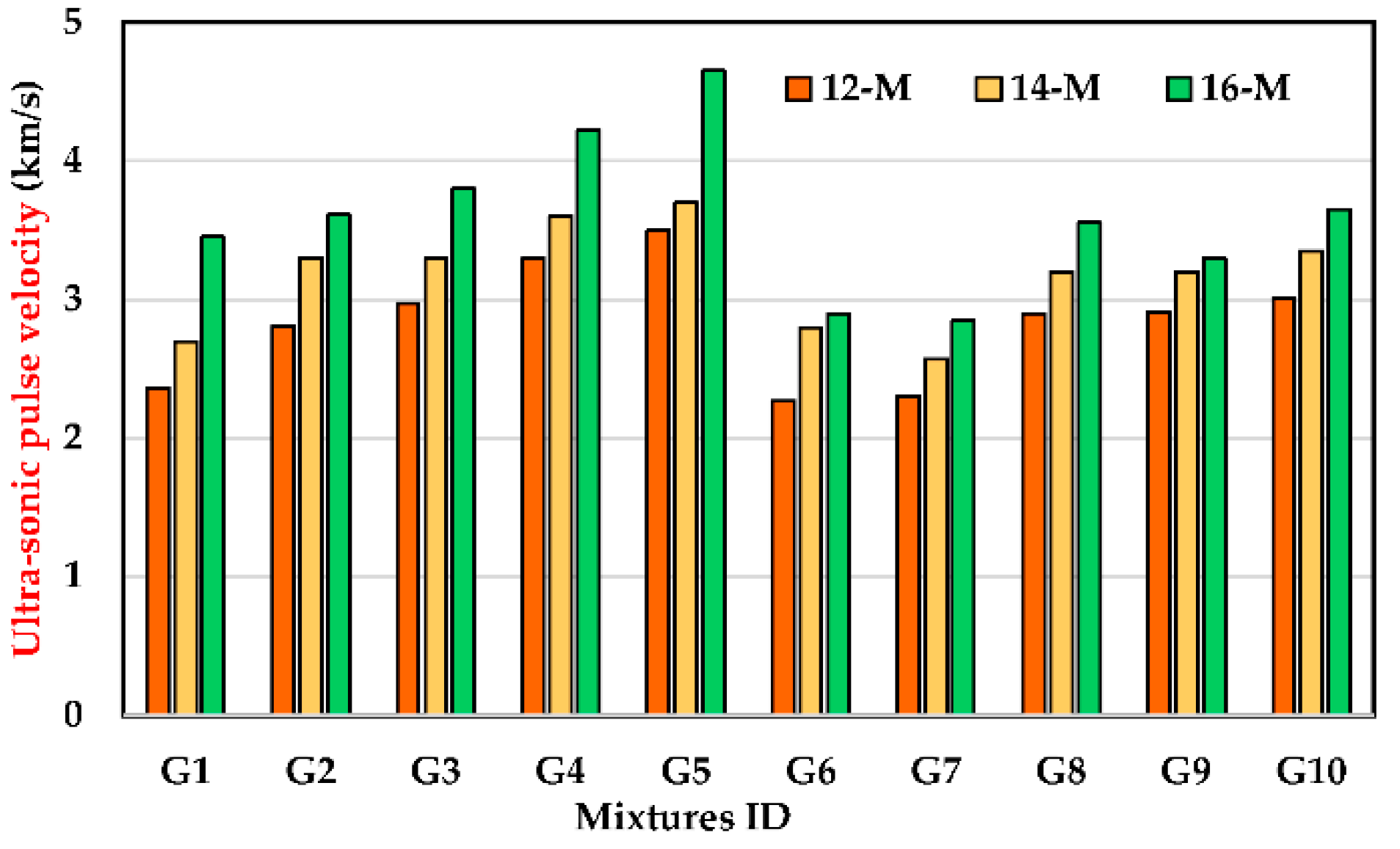
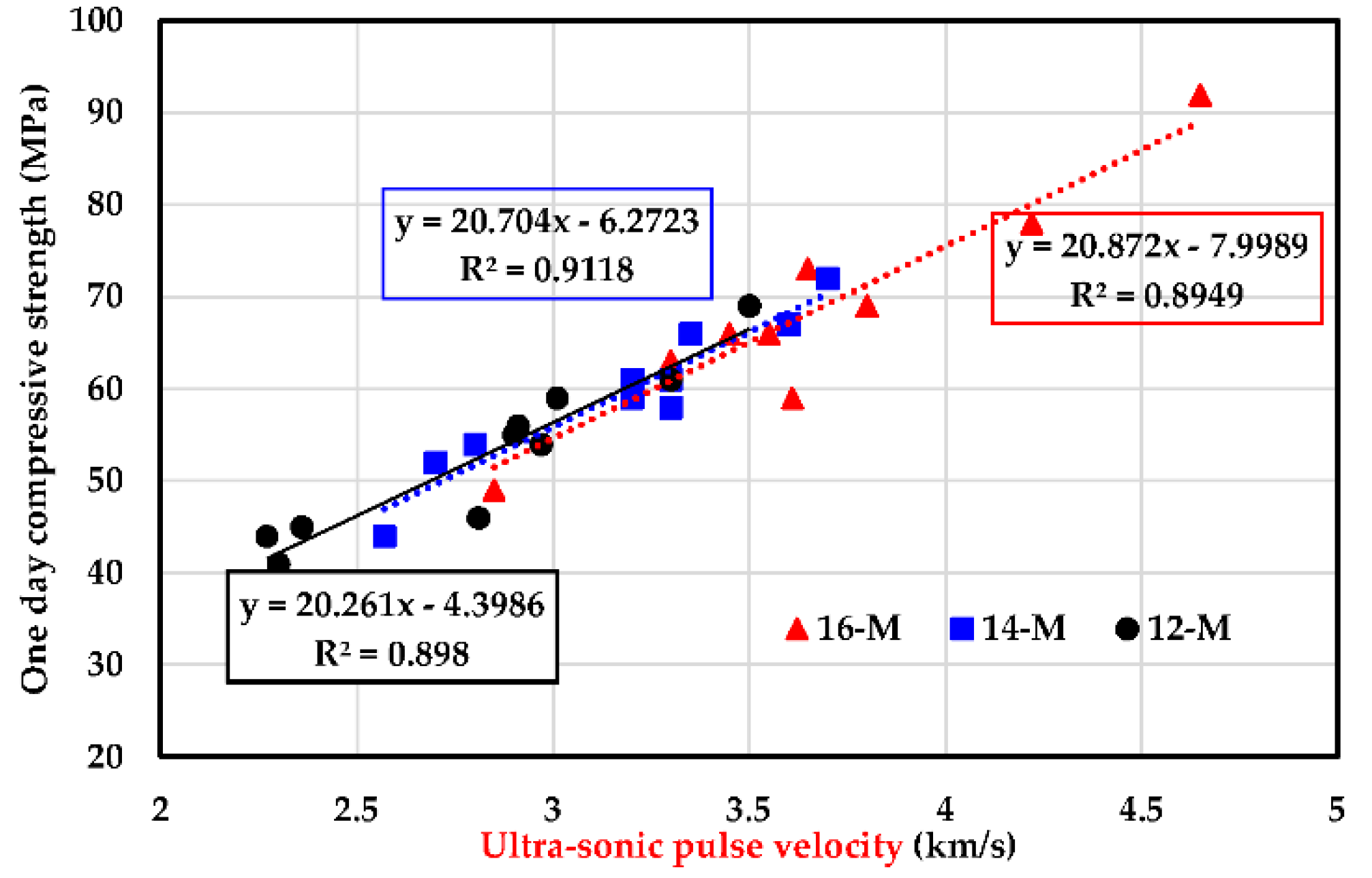
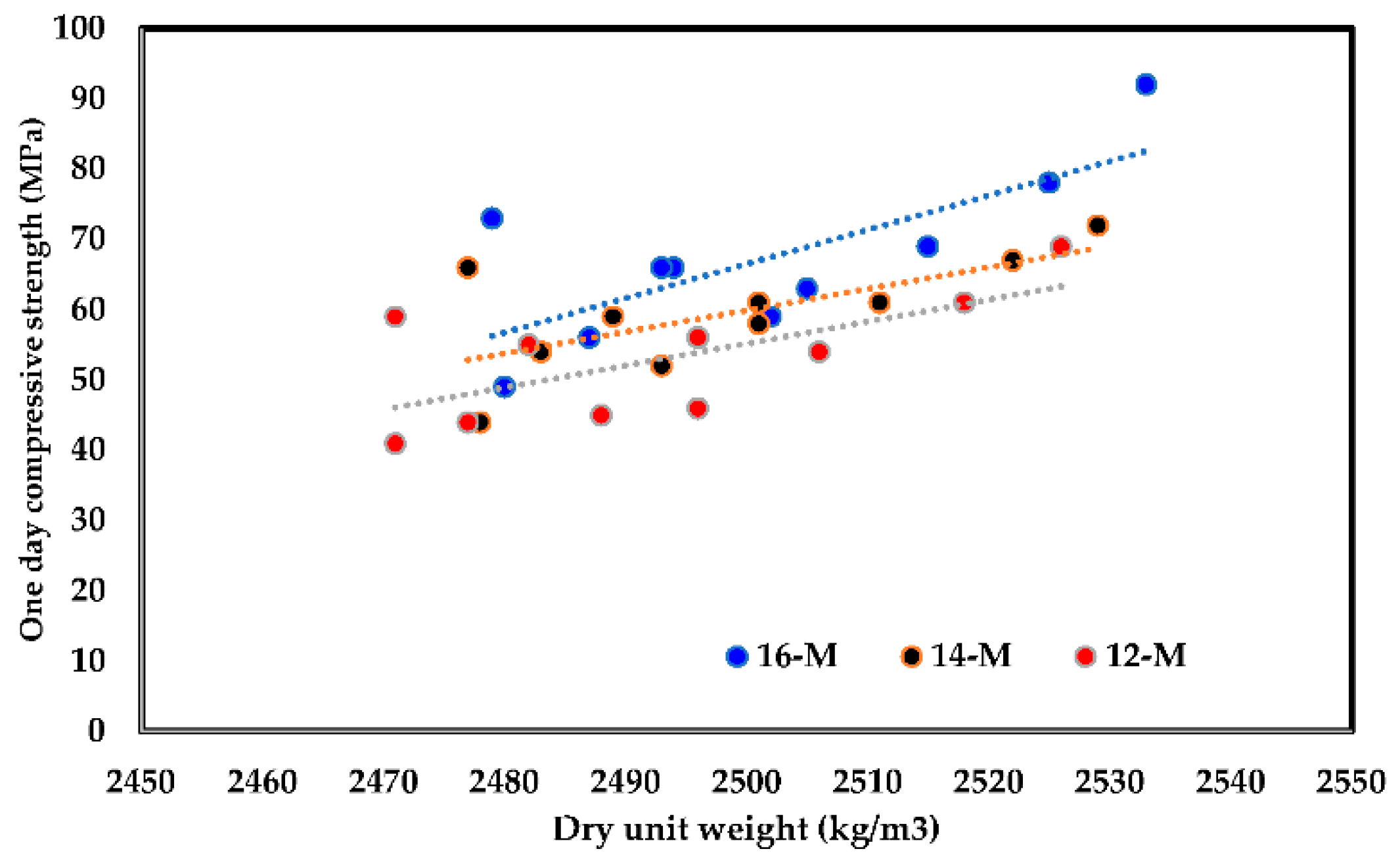


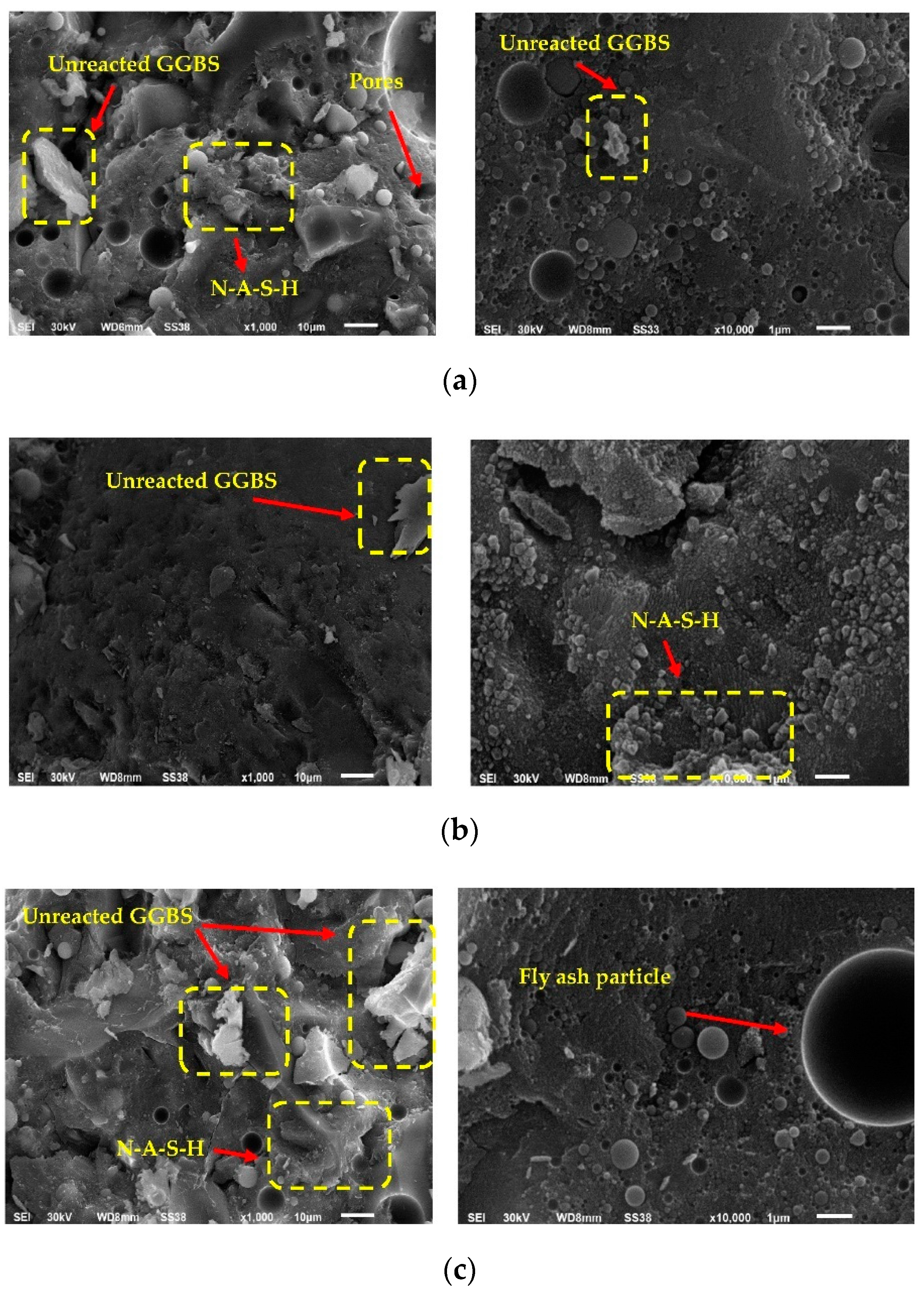
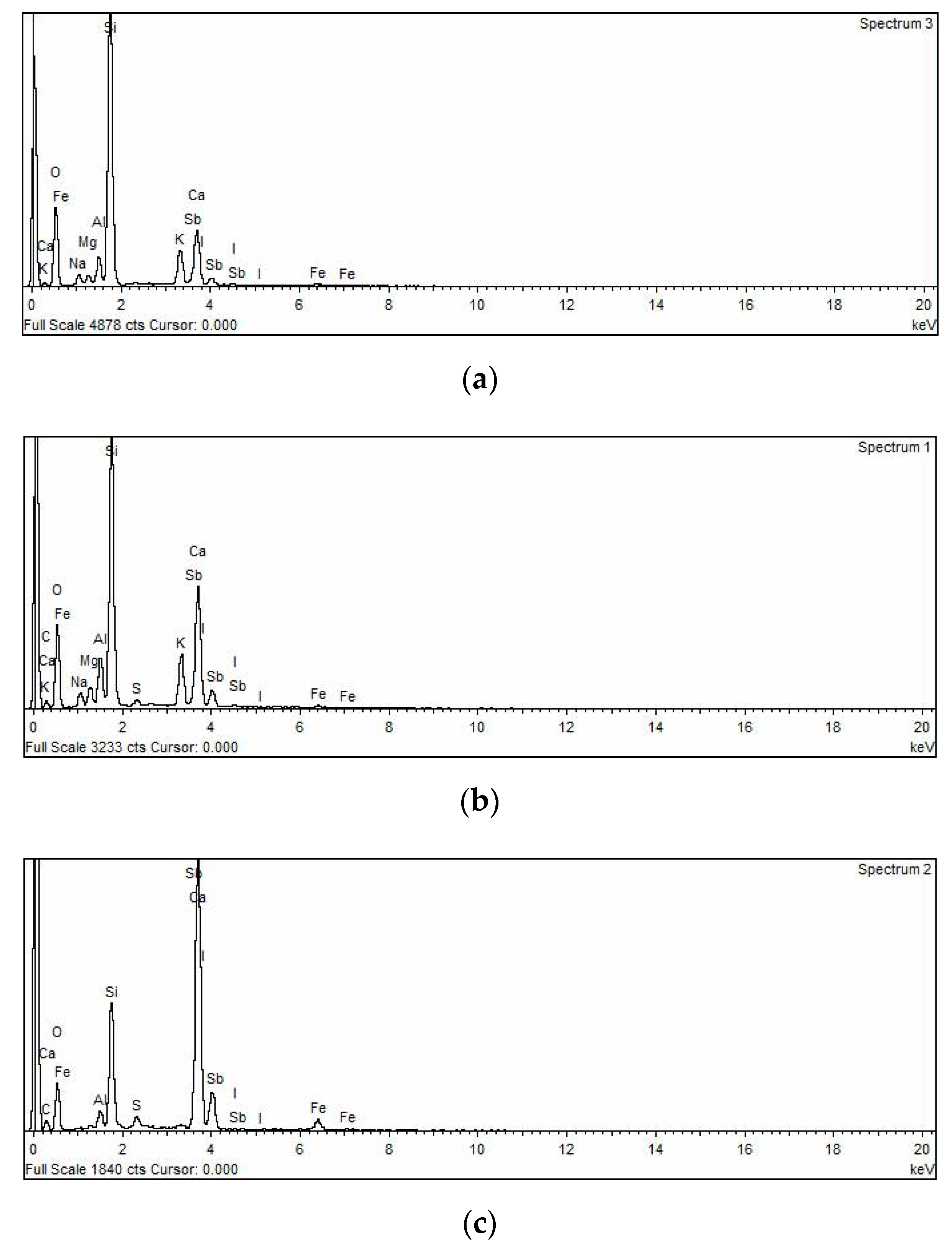

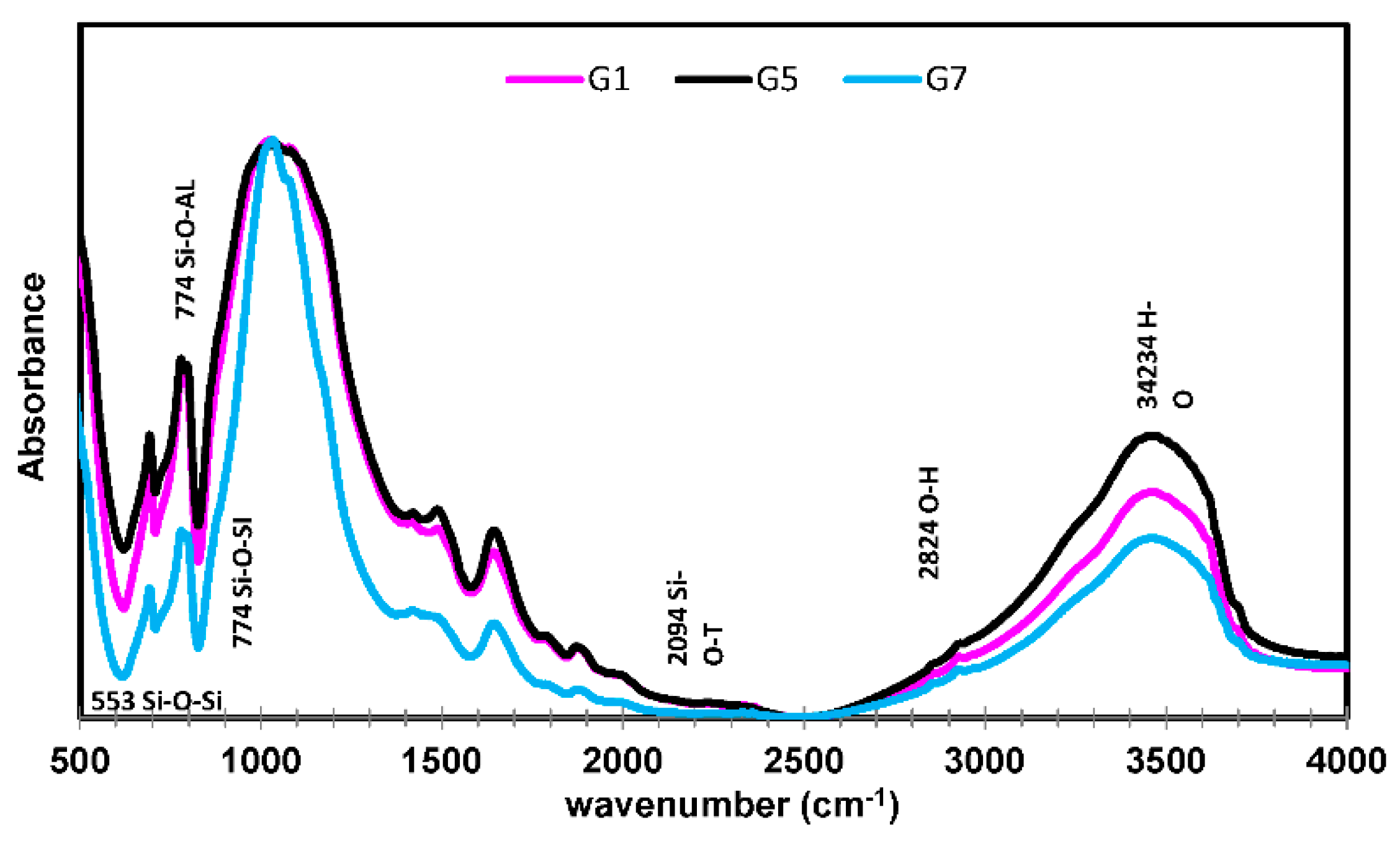
| Composition (%). | SiO2 | Al2O3 | TiO2 | Fe2O3 | P2O5 | MgO | CaO | MnO | K2O | Na2O |
|---|---|---|---|---|---|---|---|---|---|---|
| GGBS | 41.66 | 13.96 | 0.68 | 1.59 | 0.06 | 5.67 | 34.53 | 0.39 | 0.97 | 0.49 |
| SF | 98.86 | 0.12 | - | 0.14 | - | 0.2 | 0.12 | 0.35 | 0.21 | - |
| FA | 62.19 | 28.18 | 2.37 | 4.54 | 0.47 | 0.49 | 0.58 | 0.07 | 1.05 | 0.06 |
| Parameters | (%) of ASM | KOH Molarity (M) | Curing Temperature (°C) | W/ASM Ratio | ||
|---|---|---|---|---|---|---|
| GGBS | SF | FA | ||||
| Values | 60–100 | 0–30 | 10 | 12-14-16 | Ambient, 60, and 100 | 0.211-.0221 |
| Series No. | Mixtures ID | ASM | Natural Sand | |||
|---|---|---|---|---|---|---|
| GGBS | SF | FA | Grade I | Grade II | ||
| Ref. | G1 | 865 | - | - | 383 | 766 |
| Series 1 | G2 | 800 | 51 | - | 383 | 766 |
| G3 | 744 | 102 | - | 383 | 766 | |
| G4 | 699 | 154 | - | 383 | 766 | |
| G5 | 644 | 205 | - | 383 | 766 | |
| Series 2 | G6 | 865 | - | 66 | 383 | 766 |
| G7 | 713 | 51 | 66 | 383 | 766 | |
| G8 | 648 | 102 | 66 | 383 | 766 | |
| G9 | 583 | 154 | 66 | 383 | 766 | |
| G10 | 518 | 205 | 66 | 383 | 766 | |
| Mixtures ID | Molar Ratio | ASM/Sand | W/ASM At 16 M | ||
|---|---|---|---|---|---|
| Na2O/SiO2 | H2O/Na2O | SiO2/Al2O3 | |||
| G1 | 0.22 | 8.54 | 2.98 | 0.753 | 0.211 |
| G2 | 0.21 | 8.56 | 3.56 | 0.741 | 0.214 |
| G3 | 0.2 | 8.57 | 4.23 | 0.736 | 0.216 |
| G4 | 0.19 | 8.59 | 5.03 | 0.742 | 0.214 |
| G5 | 0.19 | 8.6 | 6.01 | 0.739 | 0.215 |
| G6 | 0.21 | 8.54 | 2.85 | 0.735 | 0.216 |
| G7 | 0.21 | 8.58 | 3.35 | 0.723 | 0.220 |
| G8 | 0.2 | 8.59 | 3.93 | 0.718 | 0.221 |
| G9 | 0.19 | 8.61 | 4.61 | 0.725 | 0.219 |
| G10 | 0.18 | 8.62 | 5.42 | 0.721 | 0.220 |
| Reference | Cementitious Material Used | Alkali Activator Used | Early CS (MPa) | Conclusion |
|---|---|---|---|---|
| Current study | GGBS, FA and SF | KOH + Na2SiO3 | 16–134 | Increasing KOH molarity, enhancement of geopolymerization process, heat curing, and control the gradation of ASM and filler materials. |
| Nath et al. [48] | FA and GGBS | NaOH + Na2SiO3 | 40–63 | Changing the Na2SiO3 to NaOH ratio from 1.5 to 2.5 resulted in a small loss in strength over time. |
| Assi et al. [49] | FA + SF | NaOH + Na2SiO3 | 93–106 | SF-based activating solution increased CS compared to Na2SiO3-based activating solution. |
| Duan et al. [50] | Metakaolin | NaOH + Na2SiO3 | 20–50 | At 3 h early curing, CS, and bond strengths approach 10 MPa and 0.6 MPa, respectively. |
| Shen et al. [51] | crushed waste brick | NaOH + Na2SiO3 | 5–31 | At 6% alkali dosage and 3 days curing (70 °C, 30% Relative humidity), GPC’s CS reaches 31.1 MPa. |
| Alanazi et al. [37] | Metakaolin + GGBS | NaOH + Na2SiO3 | 21–58 | A silicon dioxide/sodium oxide molar ratio of 10 accelerated geopolymerization and increased CS. |
| Assi et al. [42] | FA + SF | NaOH | 30–68.5 | NaOH affects CS. a 60–100% NaOH to binder ratio gives acceptable CS. |
| Li et al. [52] | GGBS | NaOH | 16–41 | GPC’s early CS was 120% higher than PCC’s (1 d) and its setting time was faster. |
| Elyamany et al. [41] | FA + SF + GGBS | NaOH+ Na2SiO3 | 35–45 | Addition of GGBS and SF achieves better properties compared to fly ash only |
| Mixtures ID | G1 | G2 | G3 | G4 | G5 | G6 | G7 | G8 | G9 | G10 |
|---|---|---|---|---|---|---|---|---|---|---|
| Porosity (%) | 2.77 | 3.27 | 2.61 | 2.57 | 1.89 | 3.73 | 3.65 | 3.03 | 2.87 | 2.81 |
| Standard devi. (%) | ±2.11 | ±4.61 | ±3.73 | ±1.61 | ±1.97 | ±2.44 | ±3.61 | ±2.11 | ±4.17 | ±3.05 |
Publisher’s Note: MDPI stays neutral with regard to jurisdictional claims in published maps and institutional affiliations. |
© 2022 by the authors. Licensee MDPI, Basel, Switzerland. This article is an open access article distributed under the terms and conditions of the Creative Commons Attribution (CC BY) license (https://creativecommons.org/licenses/by/4.0/).
Share and Cite
Abdellatief, M.; Alanazi, H.; Radwan, M.K.H.; Tahwia, A.M. Multiscale Characterization at Early Ages of Ultra-High Performance Geopolymer Concrete. Polymers 2022, 14, 5504. https://doi.org/10.3390/polym14245504
Abdellatief M, Alanazi H, Radwan MKH, Tahwia AM. Multiscale Characterization at Early Ages of Ultra-High Performance Geopolymer Concrete. Polymers. 2022; 14(24):5504. https://doi.org/10.3390/polym14245504
Chicago/Turabian StyleAbdellatief, Mohamed, Hani Alanazi, Mohammed K. H. Radwan, and Ahmed M. Tahwia. 2022. "Multiscale Characterization at Early Ages of Ultra-High Performance Geopolymer Concrete" Polymers 14, no. 24: 5504. https://doi.org/10.3390/polym14245504
APA StyleAbdellatief, M., Alanazi, H., Radwan, M. K. H., & Tahwia, A. M. (2022). Multiscale Characterization at Early Ages of Ultra-High Performance Geopolymer Concrete. Polymers, 14(24), 5504. https://doi.org/10.3390/polym14245504










